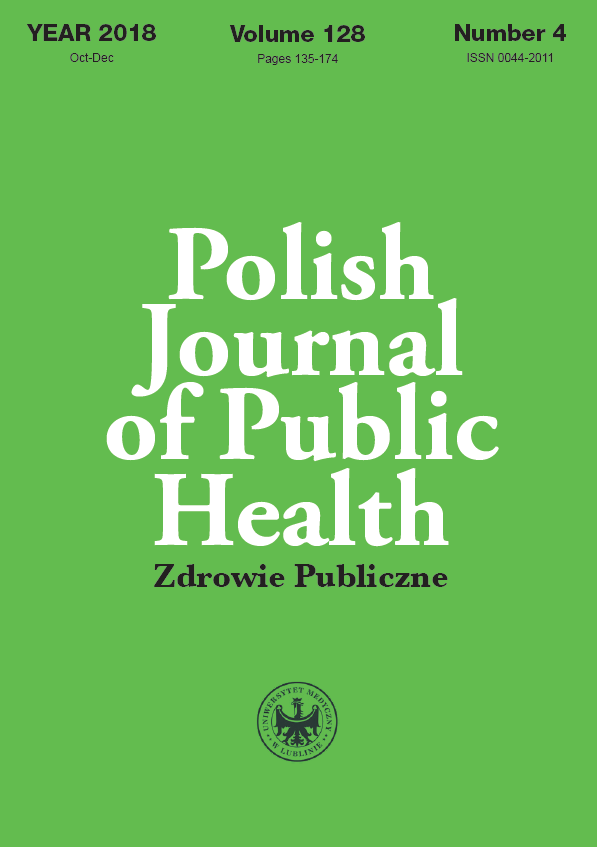Impact of the comprehensive outpatient rehabilitation on reducing intensification of depressive symptoms in people over 60 years of age
DOI:
https://doi.org/10.2478/pjph-2018-0029Keywords:
IPAQ, GDS, physical activity, symptoms of depression, seniors, rehabilitation , endurance trainingAbstract
Introduction. As a result of involution processes and diseases, changes occur in the human body, as a result of which, psychophysical fitness declines with age. Comprehensive rehabilitation is the way of improving and maintaining health condition, including, among others, the appropriate level of physical activity and the quality of affective functioning. This type of program was carried out as part of the Outpatient Healthcare Home (DDOM) at the Witold Chodźko Institute of Rural Health in Lublin.
Aim. The objective of the present study was to assess the impact of comprehensive ambulatory rehabilitation, including tailored endurance training preceded by an ergospirometry test, on indicators demonstrating the level of involvement in daily physical activities and the severity of depressive symptoms of patients over 60 years of age receiving health services at DDOM.
Material and methods. The study involved 60 seniors participating in the rehabilitation cycle implemented as part of the services provided to patients at DDOM of the Witold Chodźko Institute of Rural Health in Lublin. The tests were carried out in the test-retest model on the first and last day of the kinesiotherapy cycle. The tests were performed with use of International Physical Activity Questionnaire IPAQ and Geriatric Depression Scale GDS. The patient rehabilitation program included adapted systemic kinesiotherapy (endurance training with a load determined according to individual exercise capacity, as determined on the basis
of the ergospirometry test) and local kinesiotherapy and physical therapy adapted to the needs resulting from the condition of the musculoskeletal system.
Results. After the completion of the rehabilitation cycle we compared the tests carried out before it, and the patients received higher scores in the scales of IPAQ questionnaire for measuring weekly, intensive and mode-rate physical activity and time required for walking and were less likely to spend their time sitting or lying down. There were also lower scores of the respondents in GDS scale used to assess the severity of depressive symptoms.
Conclusions. As a result of the rehabilitation program applied, DDOM patients simultaneously obtained the desired changes in the level of involvement in physical activity and minimization of the intensity of depressive symptoms.
References
1. Bouaziz W, Kanagaratnam L, Vogel T, Schmitt E, et al. Effect of aerobic training on peak oxygen uptake among seniors aged 70 or older: a meta-analysis of randomized controlled trials. Rejuvenation Res. 2018. 21(4):341-349.
2. Greysen SR, Stijacic Cenzer I, Auerbach AD, Covinsky KE. Functional impairment and hospital readmission in Medicare seniors. JAMA Intern Med. 2015;175(4):559-65.
3. Jamour M, Marburger C, Runge M, et al. Effectiveness of geriatric rehabilitation in the oldest old: evaluation of South German observational data. Z Gerontol Geriatr. 2014;47(5):389-96.
4. Instytut Medycyny Wsi. Dzienny Dom Opieki Medycznej w Lublinie. http://www.imw.lublin.pl/index.php/pl/rejestracja-ddom. (access: 2018.08.14.).
5. WHO.http://www.who.int/topics/physical_activity/en/. (access: 2018.08.14.).
6. Yang J-E, Lee T-Y, Kim J-K. The effect of a VR exercise program on falls and depression in the elderly with mild depression in the local community. J Phys Ther Sci. 2017;29(12):2157-9.
7. Neviani F, Belvederi Murri M, et al. Physical exercise for late life depression: effects on cognition and disability. Int Psychogeriatr. 2017;29(7):1105-12.
8. Olsson LA, Hurtig-Wennlöf A, Nilsson TK. Subjective well-being in Swedish active seniors and its relationship with physical activity and commonly available biomarkers. Clin Interv Aging. 2014;9:1233-9.
9. Andrade-Gómez E, Martínez-Gómez D, Rodríguez-Artalejo F, García- Esquinas E. Sedentary behaviors, physical activity, and changes in depression and psychological distress symptoms in older adults. Depress Anxiety; 2018. 35(9):884-897.
10. Hwang J, Wang L, Siever J, et al. Loneliness and social isolation among older adults in a community exercise program: a qualitative study. Aging Ment Health. 2018;15:1-7.
11. Motalebi SA, Cheong LS, Iranagh JA, Mohammadi F. Effect of low-cost resistance training on lower-limb strength and balance in institutionalized seniors. Exp Aging Res. 2018; 44(1):48-61.
12. Virág A, Harkányi I, Karóczi CK, Vass Z, Kovács É. Study of the effects of multimodal exercise program on physical fitness and health perception in community-living Hungarian older adults. J Sports Med Phys Fitness. 2018;58(5):669-77.
13. Biernat E, Stupnicki R, Gajewski AK. Międzynarodowy Kwestionariusz Aktywności Fizycznej (IPAQ) – wersja polska. Wych Fiz Sport. 2007;51(1):47-54.
14. Grodzicki T, Kocemba J, Skalska A. Geriatria z elementami gerontologii ogólnej.Gdańsk: Via Medica; 2006.
15. Silva PA, Cochrane A, Farrell H. The effectiveness of technology-mediated dance interventions and their impact on psychosocial factors in older adults: a systematic review and meta-analysis. Games Health J; 2018. 7(6):347-361.
16. Bouaziz W, Schmitt E, Vogel T, et al. Effects of interval aerobic training program with recovery bouts on cardiorespiratory and endurance fitness in seniors. Scand J Med Sci Sports. 2018. 28:2284-2292.
17. Zhu J, Xu L, Sun L, Li J, et al. Chronic disease, disability, psychological distress and suicide ideation among rural elderly: results from a population survey in Shandong. Int J Environ Res Public Health. 2018;15(8).
18. Burke L, Jancey JM, Howat P, et al. Physical Activity and Nutrition Program for Seniors (PANS): process evaluation. Health Promot Pract. 2013;14(4):543-51.
19. Chen BP, Awasthi R, Sweet SN, et al. Four-week prehabilitation program is sufficient to modify exercise behaviors and improve preoperative functional walking capacity in patients with colorectal cancer. Support Care Cancer Off J Multinatl Assoc Support Care Cancer. 2017;25(1):33-40.
20. Jacquart SD, Marshak HH, Dos Santos H, et al. The effects of simultaneous exercise and psychotherapy on depressive symptoms in inpatient, psychiatric older adults. Adv Mind Body Med. 2014;28(4):8-17.
21. van Gelder BM, Tijhuis MR, Kalmijn S, et al. Physical activity in relation to cognitive decline in elderly men: the FINE Study. Neurology. 2004;63(12):2316-21.
22. Mazurek K, Żmijewski P, Kozdroń E, et al. Cardiovascular risk reduction in sedentary postmenopausal women during organized physical activity. Kardiol Pol. 2017;75(5):476-85.
Downloads
Published
Issue
Section
License
Copyright (c) 2019 Polish Journal of Public Health

This work is licensed under a Creative Commons Attribution-NonCommercial-NoDerivatives 3.0 Unported License.


